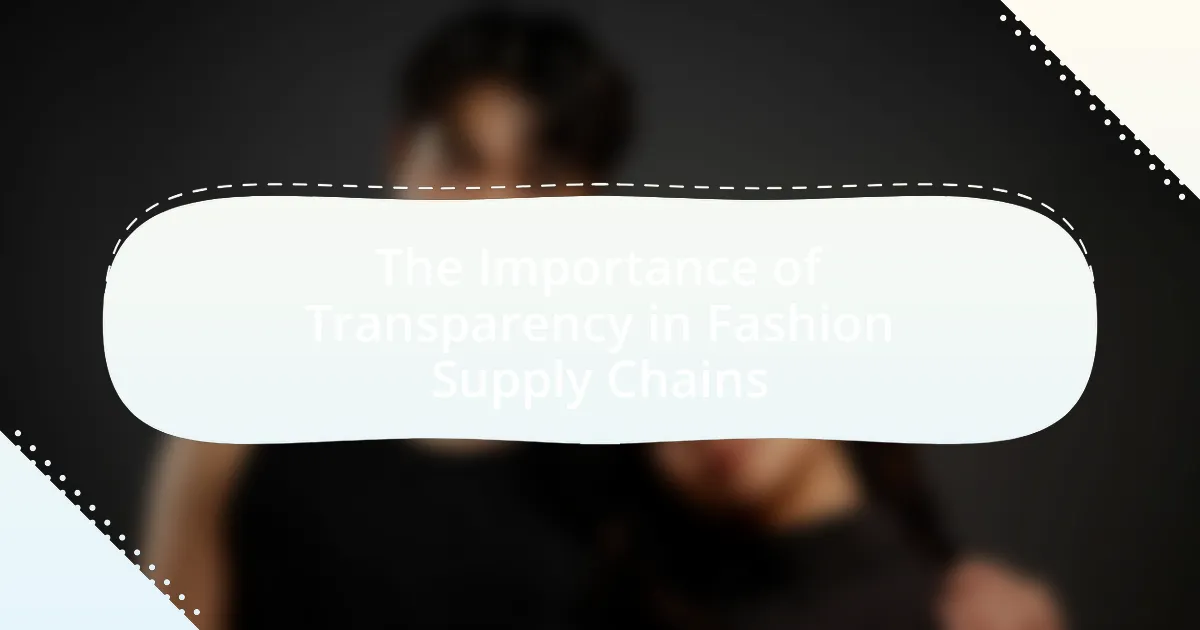Transparency in fashion supply chains is essential for promoting ethical practices and building consumer trust. The article examines the significance of transparency, highlighting its role in ensuring accountability, mitigating risks of labor exploitation, and fostering sustainable practices. It discusses the ethical implications of a lack of transparency, the impact on consumer trust, and the key components necessary for a transparent supply chain. Additionally, the article explores the challenges brands face in achieving transparency, the influence of regulatory requirements, and the benefits for stakeholders. It also outlines best practices for brands to enhance transparency and the emerging trends and innovations supporting these initiatives.

What is the Importance of Transparency in Fashion Supply Chains?
Transparency in fashion supply chains is crucial for fostering ethical practices and consumer trust. It enables stakeholders to trace the origins of materials, ensuring that labor conditions and environmental impacts are responsibly managed. For instance, a 2020 report by the Fashion Transparency Index found that only 40% of major fashion brands disclose their suppliers, highlighting a significant gap in accountability. By increasing transparency, brands can mitigate risks related to labor exploitation and environmental degradation, ultimately leading to more sustainable practices and informed consumer choices.
Why is transparency crucial in the fashion industry?
Transparency is crucial in the fashion industry because it fosters accountability and ethical practices throughout the supply chain. By providing clear information about sourcing, production processes, and labor conditions, brands can build trust with consumers who increasingly demand ethical standards. Research from the Fashion Transparency Index indicates that 75% of consumers are more likely to purchase from brands that are transparent about their supply chains. This transparency not only enhances brand reputation but also encourages sustainable practices, as companies are held accountable for their environmental and social impacts.
What are the ethical implications of a lack of transparency?
A lack of transparency in fashion supply chains raises significant ethical implications, primarily concerning exploitation and accountability. When companies do not disclose their sourcing and production practices, it becomes difficult to ensure fair labor conditions, leading to potential human rights violations such as child labor and unsafe working environments. For instance, the 2013 Rana Plaza collapse in Bangladesh, which resulted in over 1,100 deaths, highlighted the dire consequences of opaque supply chains, as many brands were unaware of the unsafe conditions in factories they contracted. Furthermore, a lack of transparency undermines consumer trust, as individuals are increasingly demanding ethical practices from brands. According to a 2021 survey by McKinsey, 67% of consumers consider sustainability and transparency important when making purchasing decisions. Thus, the ethical implications of insufficient transparency not only affect workers but also impact consumer behavior and brand reputation.
How does transparency impact consumer trust?
Transparency significantly enhances consumer trust by providing clear and accessible information about products and their origins. When brands openly share details regarding their supply chains, production processes, and sourcing practices, consumers feel more informed and empowered in their purchasing decisions. Research indicates that 94% of consumers are likely to be loyal to a brand that offers complete transparency, as highlighted in a 2020 study by Label Insight. This trust is further reinforced when brands demonstrate accountability and ethical practices, leading to stronger customer relationships and increased brand loyalty.
What are the key components of a transparent supply chain?
The key components of a transparent supply chain include traceability, visibility, accountability, and communication. Traceability allows stakeholders to track the origin and journey of products through the supply chain, ensuring that every step is documented and verifiable. Visibility involves providing real-time access to data regarding inventory levels, production processes, and logistics, enabling informed decision-making. Accountability ensures that all parties in the supply chain are responsible for their actions and adhere to ethical standards, which can be reinforced through audits and certifications. Lastly, effective communication fosters collaboration among suppliers, manufacturers, and retailers, facilitating the sharing of information and best practices. These components collectively enhance trust and ethical practices within the fashion industry, as evidenced by studies showing that brands with transparent supply chains experience increased consumer loyalty and reduced risks of supply chain disruptions.
What role do suppliers play in ensuring transparency?
Suppliers play a critical role in ensuring transparency within fashion supply chains by providing accurate and timely information about their sourcing practices, production processes, and labor conditions. This transparency is essential for brands to assess compliance with ethical standards and sustainability goals. For instance, suppliers who share detailed data about their materials, manufacturing methods, and workforce conditions enable brands to trace the origins of their products, thereby fostering accountability. Research from the Fashion Transparency Index indicates that brands with transparent supply chains are more likely to engage in responsible sourcing and labor practices, which enhances consumer trust and brand reputation.
How can technology enhance supply chain transparency?
Technology enhances supply chain transparency by enabling real-time tracking and data sharing across all stages of the supply chain. For instance, blockchain technology provides an immutable ledger that records every transaction, allowing stakeholders to verify the authenticity and origin of products. According to a report by the World Economic Forum, implementing blockchain can reduce supply chain fraud by up to 50%. Additionally, Internet of Things (IoT) devices facilitate continuous monitoring of goods, ensuring that conditions such as temperature and humidity are maintained, which is crucial for perishable items. This level of visibility not only builds consumer trust but also helps companies identify inefficiencies and respond swiftly to disruptions.
What challenges do brands face in achieving transparency?
Brands face significant challenges in achieving transparency, primarily due to complex supply chains and varying standards of disclosure. The intricate nature of global supply chains often involves multiple tiers of suppliers, making it difficult for brands to track and verify the origins of materials and labor practices. Additionally, inconsistent regulations across different countries can hinder uniform transparency efforts, as brands may not be required to disclose the same information in every market. A study by the Fashion Transparency Index indicates that only 40% of major fashion brands disclose their supply chain information, highlighting the widespread difficulty in achieving full transparency.
What are the common barriers to transparency in fashion supply chains?
Common barriers to transparency in fashion supply chains include complex supply chain structures, lack of standardized data reporting, and insufficient regulatory frameworks. Complex supply chains often involve multiple tiers of suppliers, making it difficult to trace the origin of materials and labor practices. Additionally, the absence of standardized data reporting means that companies may not share consistent information about their sourcing and production processes. Furthermore, insufficient regulatory frameworks can lead to a lack of accountability, allowing companies to operate without disclosing critical information about their supply chains. These barriers hinder efforts to achieve transparency and accountability in the fashion industry.
How do regulatory requirements affect transparency efforts?
Regulatory requirements significantly enhance transparency efforts by mandating disclosure of information related to supply chain practices. These regulations, such as the Modern Slavery Act and the EU’s Supply Chain Due Diligence Directive, compel companies to report on their sourcing, labor conditions, and environmental impact. Compliance with these laws not only fosters accountability but also builds consumer trust, as evidenced by a 2021 report from the Fashion Transparency Index, which found that brands adhering to regulatory standards scored higher in transparency metrics. Thus, regulatory frameworks serve as critical drivers for improved transparency in fashion supply chains.

How does transparency benefit stakeholders in the fashion supply chain?
Transparency benefits stakeholders in the fashion supply chain by fostering trust, enhancing accountability, and promoting ethical practices. When brands disclose information about sourcing, production processes, and labor conditions, consumers can make informed choices, leading to increased brand loyalty and sales. Additionally, suppliers and manufacturers are held accountable for their practices, which can improve working conditions and reduce exploitation. Research from the Fashion Transparency Index indicates that brands with higher transparency scores tend to have better sustainability practices, which positively impacts their reputation and stakeholder relationships.
What advantages does transparency offer to consumers?
Transparency offers consumers the advantage of informed decision-making. When brands disclose information about their supply chains, consumers can assess the ethical practices, sustainability, and quality of products. For instance, a study by the Fashion Transparency Index found that 40% of consumers are more likely to purchase from brands that provide clear information about their sourcing and production processes. This access to information empowers consumers to support companies that align with their values, ultimately fostering trust and loyalty.
How does transparency influence purchasing decisions?
Transparency significantly influences purchasing decisions by building consumer trust and loyalty. When brands openly share information about their supply chains, including sourcing practices, labor conditions, and environmental impact, consumers are more likely to feel confident in their purchases. A study by Nielsen found that 66% of global consumers are willing to pay more for sustainable brands, indicating that transparency regarding ethical practices can directly affect buying behavior. Furthermore, transparency can differentiate brands in a crowded market, as consumers increasingly seek authenticity and accountability in their purchases.
What role does consumer awareness play in promoting transparency?
Consumer awareness plays a crucial role in promoting transparency by empowering individuals to demand ethical practices from brands. When consumers are informed about the implications of their purchasing decisions, they are more likely to seek out brands that prioritize transparency in their supply chains. Research indicates that 66% of global consumers are willing to pay more for sustainable brands, highlighting the direct impact of consumer awareness on corporate behavior. This increased demand for transparency compels companies to disclose information about sourcing, labor practices, and environmental impact, thereby fostering a culture of accountability within the fashion industry.
How does transparency affect brand reputation?
Transparency significantly enhances brand reputation by fostering trust and loyalty among consumers. When brands openly share information about their supply chains, production processes, and sourcing practices, they demonstrate accountability and ethical standards. A study by Cone Communications found that 87% of consumers are more likely to purchase from a company that advocates for social and environmental issues, indicating that transparency aligns with consumer values. Furthermore, brands that maintain transparency are less likely to face backlash during crises, as consumers are more forgiving towards companies that communicate openly. This correlation between transparency and positive brand perception underscores its critical role in building and maintaining a strong reputation in the fashion industry.
What are the long-term benefits of maintaining a transparent supply chain?
Maintaining a transparent supply chain leads to enhanced trust and loyalty among consumers, which is crucial for long-term business success. Transparency allows brands to demonstrate ethical practices, thereby attracting a growing segment of consumers who prioritize sustainability and ethical sourcing. According to a 2021 survey by McKinsey, 66% of consumers are willing to pay more for sustainable brands, indicating that transparency can directly influence purchasing decisions and brand loyalty. Furthermore, transparent supply chains can reduce risks related to compliance and reputational damage, as companies are better equipped to identify and address issues proactively. This proactive approach can lead to cost savings and operational efficiencies over time, reinforcing the overall resilience and competitiveness of the business in the market.
How can transparency mitigate risks for brands?
Transparency can mitigate risks for brands by fostering trust and accountability among consumers and stakeholders. When brands openly share information about their supply chains, including sourcing practices and labor conditions, they reduce the likelihood of negative perceptions and backlash. For instance, a study by the Ethical Trading Initiative found that brands demonstrating transparency are less likely to face boycotts or reputational damage, as consumers increasingly prefer to support ethical companies. Additionally, transparency allows brands to identify and address potential issues proactively, such as labor violations or environmental concerns, thereby minimizing legal risks and enhancing brand loyalty.

What best practices can brands adopt to enhance transparency?
Brands can enhance transparency by implementing clear communication strategies, utilizing technology for traceability, and engaging in third-party audits. Clear communication involves openly sharing information about sourcing, production processes, and labor practices, which builds trust with consumers. Technology, such as blockchain, allows brands to provide verifiable data about the supply chain, ensuring that consumers can trace the origins of products. Third-party audits conducted by independent organizations validate claims made by brands, providing an unbiased assessment of their practices. According to a 2021 report by Fashion Revolution, 75% of consumers want to know more about the supply chain, highlighting the demand for transparency in the industry.
How can brands effectively communicate their supply chain practices?
Brands can effectively communicate their supply chain practices by utilizing clear, consistent messaging across multiple platforms, including websites, social media, and product labels. This approach ensures that consumers receive transparent information about sourcing, production processes, and labor conditions. For instance, brands like Patagonia and Everlane provide detailed insights into their supply chains, showcasing their commitment to ethical practices and sustainability. Research indicates that 66% of consumers are willing to pay more for sustainable brands, highlighting the importance of transparency in building trust and loyalty. By adopting such practices, brands not only enhance their credibility but also align with consumer values, ultimately driving sales and brand loyalty.
What tools and platforms can facilitate transparency in reporting?
Tools and platforms that facilitate transparency in reporting include blockchain technology, supply chain management software, and sustainability reporting platforms. Blockchain technology, such as IBM Food Trust, provides immutable records of transactions, ensuring traceability and accountability in supply chains. Supply chain management software like SAP Ariba enables companies to monitor supplier practices and compliance in real-time. Sustainability reporting platforms, such as EcoVadis, allow organizations to assess and disclose their environmental, social, and governance (ESG) performance, fostering transparency and trust among stakeholders. These tools collectively enhance visibility and accountability in fashion supply chains, supporting ethical practices and informed consumer choices.
How can brands engage consumers in their transparency journey?
Brands can engage consumers in their transparency journey by actively sharing detailed information about their supply chains and production processes. This can be achieved through initiatives such as providing access to supply chain data, showcasing ethical sourcing practices, and utilizing technology like blockchain for traceability. For instance, a study by the Fashion Transparency Index found that brands that disclose their suppliers and production methods see increased consumer trust and loyalty, as consumers are increasingly prioritizing ethical considerations in their purchasing decisions. By fostering open communication and demonstrating accountability, brands can effectively involve consumers in their transparency efforts.
What are the future trends in transparency within fashion supply chains?
Future trends in transparency within fashion supply chains include increased use of blockchain technology, enhanced data sharing practices, and a focus on sustainability metrics. Blockchain technology allows for immutable records of transactions, enabling consumers to trace the origins of products and verify claims made by brands. Enhanced data sharing practices among stakeholders, including suppliers and manufacturers, facilitate real-time access to information regarding labor conditions and environmental impact. Additionally, brands are increasingly adopting sustainability metrics to provide consumers with clear insights into their environmental and social practices, driven by consumer demand for ethical sourcing and production. These trends are supported by a growing body of research indicating that transparency can lead to improved brand loyalty and consumer trust.
How is sustainability influencing transparency initiatives?
Sustainability is driving transparency initiatives by compelling companies to disclose their environmental and social practices. As consumers increasingly demand ethical sourcing and eco-friendly production, brands are adopting transparency measures to build trust and demonstrate accountability. For instance, a 2021 survey by McKinsey found that 67% of consumers consider sustainability when making purchasing decisions, prompting brands to provide detailed information about their supply chains. This shift not only enhances brand reputation but also aligns with regulatory pressures, such as the European Union’s Sustainable Finance Disclosure Regulation, which mandates greater transparency in sustainability reporting.
What innovations are emerging to support transparency in the industry?
Innovations such as blockchain technology, digital supply chain mapping, and artificial intelligence are emerging to support transparency in the fashion industry. Blockchain provides a secure and immutable ledger that allows stakeholders to trace the origin and journey of materials, ensuring authenticity and ethical sourcing. Digital supply chain mapping tools enable brands to visualize their entire supply chain, identifying potential risks and areas for improvement in transparency. Additionally, artificial intelligence can analyze vast amounts of data to enhance visibility and predict supply chain disruptions, thereby fostering accountability. These innovations collectively contribute to a more transparent and responsible fashion supply chain.
What practical steps can brands take to improve transparency?
Brands can improve transparency by implementing traceability systems that track the origin of materials and the production processes involved. By utilizing blockchain technology, brands can provide consumers with verifiable information about the supply chain, ensuring that every step from raw material sourcing to final product delivery is documented and accessible. For instance, companies like Everledger have successfully used blockchain to trace diamonds, demonstrating the effectiveness of this technology in enhancing transparency. Additionally, brands can publish detailed sustainability reports that disclose their sourcing practices, labor conditions, and environmental impact, which fosters trust and accountability. According to a 2021 report by McKinsey, 67% of consumers are willing to pay more for sustainable products, highlighting the demand for transparency in the fashion industry.

Leave a Reply